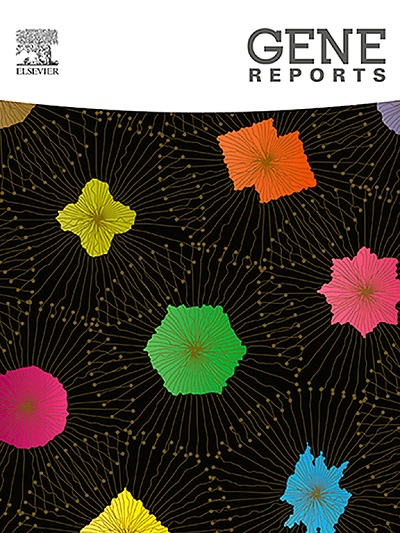揭示伊朗阿瓦士吸毒者口腔中白色念珠菌和杜布林念珠菌的基因型多样性
IF 1
Q4 GENETICS & HEREDITY
引用次数: 0
摘要
白色念珠菌是一种二倍体酵母菌,在某些条件下可引起口腔或口咽感染,尤其是免疫力低下的人。最近的分子研究已将白色念珠菌的基因型分为 A、B 和 C 三类,并将杜布林念珠菌的基因型分为 D 类。本研究旨在确定伊朗吸毒者中白念珠菌复合体的不同基因型。研究人员采集了吸毒者的口腔拭子,并在 CHROMagar 念珠菌培养基上进行培养。采用 21-plex PCR 方法检测分离物,并使用引物对 CA-INT-L 和 CA-INT-R 扩增白色念珠菌 25S rDNA 基因,对白色念珠菌进行 ABC 基因分型。在筛查的 245 名药物滥用者中,发现 151 人(61.63%)携带白念珠菌复合体。患者中最常见的基因型是基因型 D(39.1%),其次是基因型 A(31.12%)、基因型 B(9.93%)和基因型 C(5.29%)。此外,14.56%的患者具有混合基因型。值得注意的是,基因型分布与年龄、基础疾病和婚姻状况有明显差异(P < 0.05)。这项研究强调了分子基因分型在了解高危人群中白僵菌和杜布林杆菌流行病学方面的重要意义。本文章由计算机程序翻译,如有差异,请以英文原文为准。
Unveiling the genotypic diversity of Candida albicans and Candida dubliniensis in the oral cavities of drug abusers in Ahvaz, Iran
Candida albicans is a diploid yeast that, under certain conditions, can cause oral or oropharyngeal infections, particularly in immunocompromised individuals. Recent molecular investigations have classified genotypes A, B, and C for Candida albicans, along with genotype D for Candida dubliniensis. This study aimed to identify the different genotypes of the C. albicans complex in drug abusers in Iran. Oral swabs were collected from drug abusers and cultured on CHROMagar Candida. A 21-plex PCR method was employed for the detection of isolates, and the Candida 25S rDNA gene was amplified using primer pairs CA-INT-L and CA-INT-R for ABC genotyping of C. albicans. Out of the 245 substance abusers screened, 151 individuals (61.63 %) were found to harbor the C. albicans complex. The most common genotype among patients was genotype D (39.1 %), followed by genotype A (31.12 %), genotype B (9.93 %), and genotype C (5.29 %). Additionally, 14.56 % of patients had a mixed genotype. Notably, significant differences in genotype distribution were observed in relation to age, underlying diseases, and marital status (P < 0.05). This study highlights the significance of molecular genotyping in understanding the epidemiology of C. albicans and C. dubliniensis in at-risk groups.
求助全文
通过发布文献求助,成功后即可免费获取论文全文。
去求助
来源期刊

Gene Reports
Biochemistry, Genetics and Molecular Biology-Genetics
CiteScore
3.30
自引率
7.70%
发文量
246
审稿时长
49 days
期刊介绍:
Gene Reports publishes papers that focus on the regulation, expression, function and evolution of genes in all biological contexts, including all prokaryotic and eukaryotic organisms, as well as viruses. Gene Reports strives to be a very diverse journal and topics in all fields will be considered for publication. Although not limited to the following, some general topics include: DNA Organization, Replication & Evolution -Focus on genomic DNA (chromosomal organization, comparative genomics, DNA replication, DNA repair, mobile DNA, mitochondrial DNA, chloroplast DNA). Expression & Function - Focus on functional RNAs (microRNAs, tRNAs, rRNAs, mRNA splicing, alternative polyadenylation) Regulation - Focus on processes that mediate gene-read out (epigenetics, chromatin, histone code, transcription, translation, protein degradation). Cell Signaling - Focus on mechanisms that control information flow into the nucleus to control gene expression (kinase and phosphatase pathways controlled by extra-cellular ligands, Wnt, Notch, TGFbeta/BMPs, FGFs, IGFs etc.) Profiling of gene expression and genetic variation - Focus on high throughput approaches (e.g., DeepSeq, ChIP-Seq, Affymetrix microarrays, proteomics) that define gene regulatory circuitry, molecular pathways and protein/protein networks. Genetics - Focus on development in model organisms (e.g., mouse, frog, fruit fly, worm), human genetic variation, population genetics, as well as agricultural and veterinary genetics. Molecular Pathology & Regenerative Medicine - Focus on the deregulation of molecular processes in human diseases and mechanisms supporting regeneration of tissues through pluripotent or multipotent stem cells.
 求助内容:
求助内容: 应助结果提醒方式:
应助结果提醒方式:


